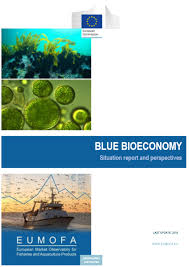EUMOFA has recently published the second edition of the study “Blue bioeconomy report”. The study aims to provide an updated overview of the European Union’s blue bioeconomy sector, focusing on cutting-edge applications of aquatic biomass by examining three topics.
Integrated Multi-Trophic Aquaculture (IMTA)
There are two key goals of IMTA. These are environmental remediation of waste materials from finfish farming, and possible additional income associated with the added biomass of the other components. IMTA has obtained encouraging, albeit not commercial-scale, results in most of its work to date in the EU and worldwide, and has shown promising environmental and economic benefits. However, difficulties remain in encouraging established mainstream producers, such as salmon farms and offshore wind farms, to integrate the types of IMTA offered.
Innovative uses for fish rest raw material (RRM) in Denmark
In 2019, the total available volume of RRM (the potentially useful material that is removed from fish in order to prepare biomass for food use) in Denmark was between 530.000 and 540.000 tonnes. In Denmark it is mainly used for fishmeal and fish oil, animal feed, biogas, and indirect human consumption. The latter of these uses achieves the highest prices when utilised for products such as food additives or supplements (e.g. oil in Omega-3 capsules). However, efforts are increasingly being made to maximise the use of RRM and retrieve as much value as possible by processing it for human consumption.
Cell-plant technology and cellular mariculture
With growing interest in cellular mariculture as an approach to address public health, environmental, and animal welfare challenges, the concept of producing plant cell culture systems could represent a potential renewable source of valuable compounds, flavours, fragrances, and colorants. In the case of seafood produced from fish cell and tissue-cultures, it represents an emerging approach to address similar challenges faced by industrial aquaculture and marine capture systems. Cell-based seafood can combine developments in biomedical engineering and modern aquaculture techniques. Aquaculture techniques such as genetic modification and closed-system aquaculture have achieved significant gains in production that could pave the way for innovation in cell-based seafood production.
The full study is available to read in English.


